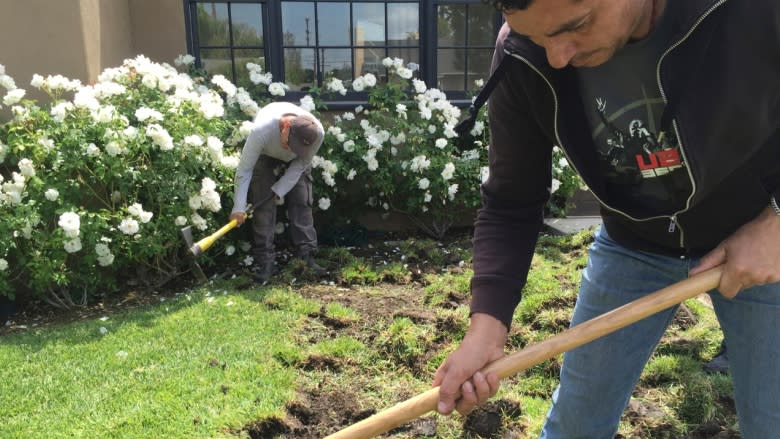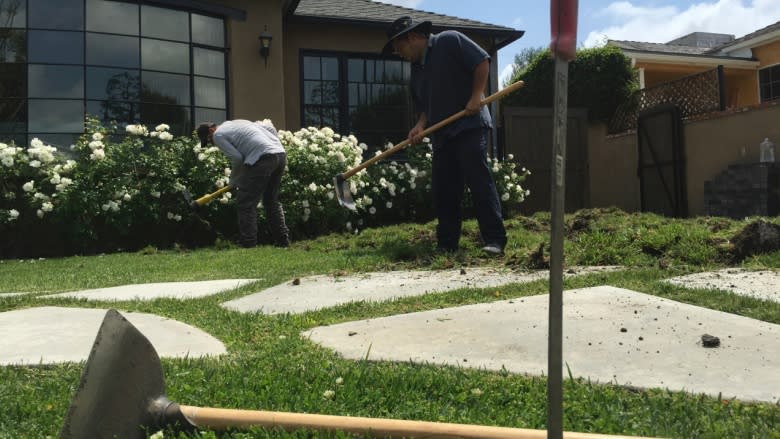Drought-stricken Californians turfing their turf for cash
For months Barbara Meloni's friends tried to convince her to do it. But she balked. She was proud of her lawn. In the upscale Los Angeles suburb of Studio City, hers is one of the lushest lawns on the block — as smooth as a putting green.
"To keep it in the shape that it's in now, it gets watered twice a day, every day," Meloni says.
For years, she says, it was easy to pretend the drought wasn't happening. But lately the stats have become too stark to ignore. The average California household uses more than 1,300 litres of water per day, and in some communities as much as 70 per cent of that is sprinkled onto lawns and gardens.
It took about a year to convince her, but finally, she says, she's in. She's doing it.
"I'm ready and it's happening," Meloni says and smiles. "It's happening today."
Francisco Sevillano and his four-man crew grab their hoes, machetes and pickaxes and start hacking. Soon, instead of water-guzzling grass, her front and back yards will sprout drought-tolerant plants. And she's hardly the first on her block. In some areas it looks like a bizarre election: Everywhere there are lawn signs bearing slogans like "I'm conserving water. Won't you join me?" In many neighbourhoods like Meloni's, brown is the new green.
"I'm seeing more of these drought-tolerant yards," Meloni says, "and they look more like artwork."
Jacky Surber, founder of the landscape design company Urbafloria, says she uses a wide range of eco-friendly plants like aloes and sage when replacing grass.
"A lot of people think it's just going to be rocks and cactus," Surber says. "But we have a lot more options than that. We're taking advantage of the rebates that are available and putting in something that's going to be sustainable long-term."
Those state and municipal rebates have been the key to convincing thousands of Californians to replace their lawns. The highest rebates are in Los Angeles, where residents get $3.75 for every square foot of turf that they rip up.
"Already things are changing," says State Water Resources Control Board Chair Felicia Marcus. "People are snapping up the rebates like there's no tomorrow."
And the program has been a windfall for landscapers.
"Business has increased," Sevillano says, taking a break from attacking Meloni's lawn. "It probably has doubled."
At least one company is offering Los Angeles residents an unusual deal: Sign over the government rebates to them and they'll do all the work for free. Bruce Killingsworth leaped at the opportunity. He points proudly at his new yard.
"This is the real Southern California," he says.
Three months ago it was a lawn like everyone else's. Now it's an expanse of grey gravel, dotted with mostly native plants like sage, hops, deer grass, and a variety of succulents. Instead of watering the whole yard with traditional hoses and sprinklers, Killingsworth's plants get their water via an underground system of pipes that only releases water under each plant.
"We cannot waste water by spraying it on dirt to grow plants a quarter of an inch high and then cut 'em off each week," he says.
The company's offer made his decision even easier: a new yard, no red tape, no wallet.
"For free they came out and tore up the lawn, they installed the drip irrigation," Killingsworth says. "They put down this layer underneath," he says, scratching away the gravel to expose the plastic sheet that prevents weeds from growing up under the gravel and plants.
But according to Surber, by using plastic and rocks instead of the more expensive compost and wood chips, the company is saving money but not necessarily saving much water. That's because the plastic sheet doesn't allow rain back into the ground, and the rocks just reflect and amplify the sun's heat.
"It's retaining a lot of heat and that heat is going back into the environment and adding to the heat island effect," Surber says.
A heat island is an urban area that's hotter than the zones that surround it due to inorganic building materials like asphalt and concrete.
Instead of rocks, she will be using a layer of biodegradable paper, then mulch and wood chips which will allow rain to replenish the groundwater.
"Healthy living soil can hold up to seven times its weight in water," she says. "So we are trying to create a storage of water within the soil."
After an hour, Barbara Meloni's front yard is beginning to look more and more bald. A year ago she would have been horrified. But the drought has changed her.
"I'm just one person and I don't think I'm going to solve the drought problem getting rid of my lawn," Meloni says, "but I think it has to start with one person."




